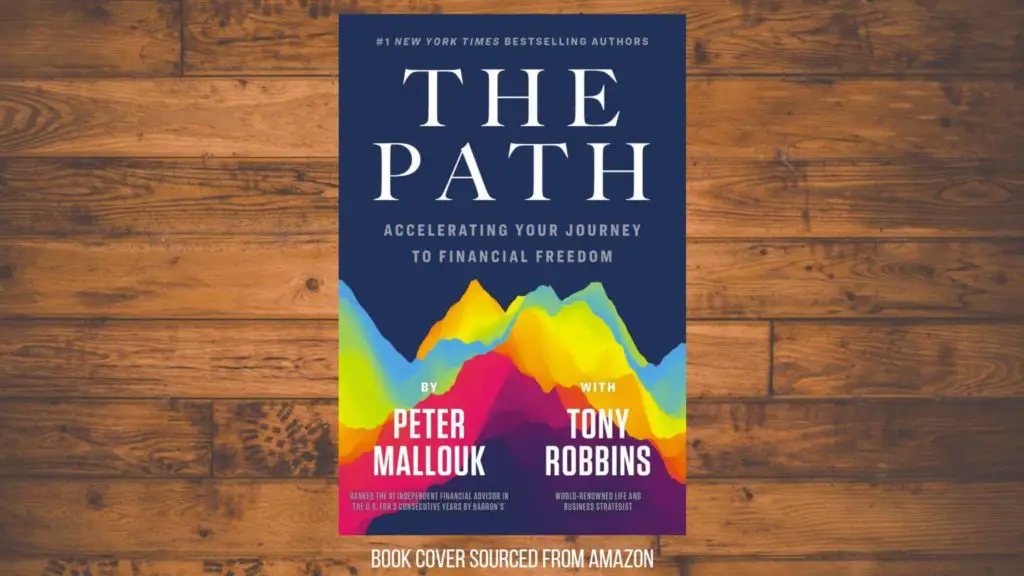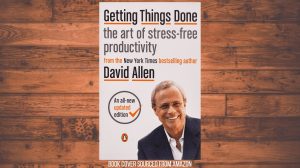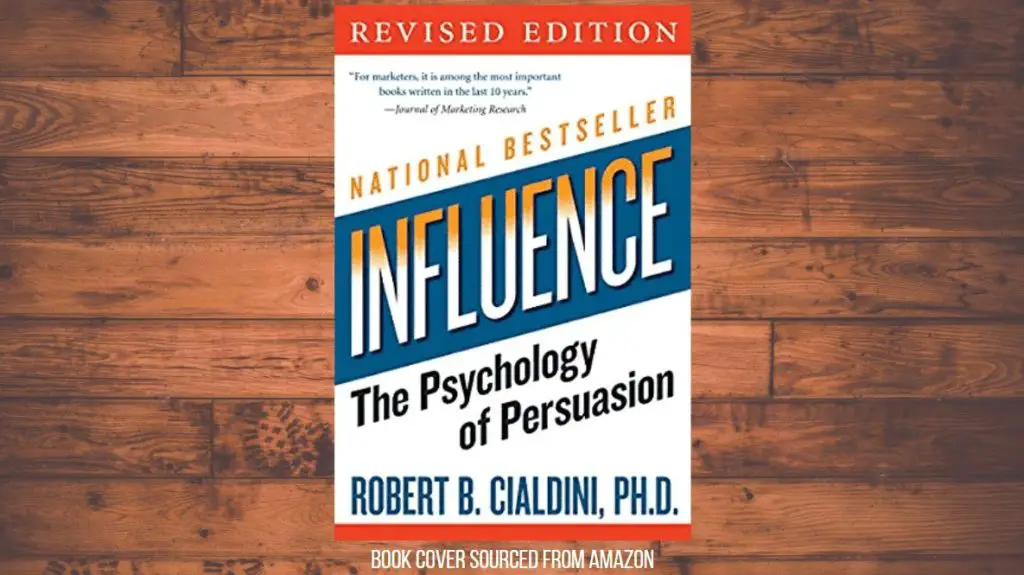This post may contain affiliate links, which means I’ll receive a commission if you purchase through my links, at no extra cost to you. Please read full disclosure for more information.
ABOUT
- Title: The Path
- Sub-title: Accelerating Your Journey to Financial Freedom
- Author: Peter Mallouk with Tony Robbins
- About the author: Peter Mallouk is the founder of Creative Planning and an accomplished financial advisor. In fact, he is the only man in history to be ranked the #1 Financial Advisor in the U.S. for three consecutive years by Barron’s (2013, 2014, 2015). Tony Robbins is a world-renowned author, life coach, motivational speaker, and philanthropist.
- Pages: 320
- Published: 2020
- Link to book
HIGH-LEVEL SUMMARY
The Path is an all-encompassing guide for your financial journey. The authors Peter Mallouk and Tony Robbins lay a path for you to achieve financial freedom by sharing knowledge, tools, strategies, and the mindset you will need along the way.
In a world full of bad news, they share their optimism about our time and future. There are many good things going on in the world and there has never been a better time to be a long-term investor. With your eyes opened to the possibilities, you can take advantage of everything the book has to offer.
The Path is divided into 5 parts:
- The Journey Ahead
- Charting Your Path
- The Trailhead
- The Climb
- The Summit
In these five parts, you learn what the journey ahead will be like. You’ll develop a plan that you can stick to. The authors will share tools and resources you’ll use as fuel for your financial freedom engine. Part 4 will share advice to stay on track, manage, and protect your wealth. In Part 5, you will learn what to do once you have reached the summit of your journey.
In this book, you’ll be learning from two world-renowned individuals. Peter Mallouk is the only person to be ranked the #1 Financial Advisor in the U.S. for three straight years. Tony Robbins has achieved financial success himself and has coached and empowered millions around the world.
Peter Mallouk and Tony Robbins will teach you how to tailor a plan for yourself. They will teach you how the markets behave and how to stay sane during the ups and downs. They’ll share what the financial services industry doesn’t want you to know so you can make wise decisions. And finally, they will teach you how to achieve happiness and fulfillment in addition to your success.
RECOMMENDATION
The Path is a book I would recommend to individuals of all ages. It’s never too early to become financially literate and plan for your future. One major key to financial freedom is having a plan set in place that you can adhere to.
This book is comprehensive in sharing what one needs to know for their financial journey. The authors keep things simple and entertaining, which makes for a pleasant read. With The Path being published in 2020, readers can be confident that they are receiving relevant advice.
TOP 25 TAKEAWAYS
1. For the vast majority, even those making great money, saving enough to become financially secure is nearly impossible. We must tap into the power that Albert Einstein called the eighth wonder of the world: compound interest.
2. Economic “winters” are actually some of the best wealth-building opportunities. If you can discipline your fear and manage your emotions, major market pullbacks can present the opportunity of a lifetime because everything is on sale.
3. Execution trumps knowledge every day of the week. There is an endless amount of content out there on personal finance and investing. You only need to know a few major things and then it comes down to execution.
4. Our brain is hardwired to focus on what is wrong—on what can harm or threaten our way of life. News and media feed into this and can stress us out, cause fear, and lead us towards poor and irrational decision-making.
5. Investors often cite one of the following as being the primary driver of stock prices: unemployment, housing, economic policy, monetary policy, the strength of the dollar, consumer confidence, retail sales, and interest rates. In fact, the stock market cares about only one thing above all else: anticipated earnings (i.e., future profits).
6. Right now is actually one of the best times in history to be a long-term, globally diversified investor. Technology is advancing and the global population is in the best position it has ever been in. More consumers and businesses are developing and this can lead to increases in the values of companies and the overall market.
7. Humans have 6 needs: 1) Certainty 2) Variety/Uncertainty 3) Significance 4) Love and Connection 5) Growth 6) Contribution.
8. Laying out a road map early in your financial journey will help you save time and money in the long run.
9. Most financial advisors will do more harm than good. Things to consider: 1) Conflict of interest. 2) Advisor vs broker. 3) Independent vs dually-registered. 4) Promoting proprietary products or not. 5) Custom vs general portfolio for all clients. 6) Custody. 7) Competence.
10. Think of your portfolio as the fuel for your plane’s engine and your financial plan as the flight instruments that will keep you on course.
11. Have an emergency cash reserve of 3 to 6 months in the bank. Extended reserves of 6 to 12 months should be put to work in safe, highly liquid assets.
12. Build a portfolio that aligns with your goals. Revisit your financial plan and projections once a year or whenever you undergo a significant life change.
13. Estate planning – In the event of your death without the proper documents, you potentially yield important decisions (like who will receive your property and who will raise your children) to the probate courts. The reality is that for a majority of individuals, only a few critical documents need to be in place to create a solid estate plan.
14. Market timing does not work. It’s also nearly impossible to consistently predict the market in the short-term. The masses, media, economists, investment managers, and newsletters get it wrong, over and over again.
15. Market corrections vs bear markets: Since 1900, corrections have happened approximately every year on average. Most corrections never achieve bear market status. Fewer than one out of five corrections actually turns into a bear market. On average, a bear market lasts close to a year, with nearly all of them lasting between 8 and 24 months.
16. The risk of being out of the market is far greater than the risk of being in.
17. Avoid these cognitive biases: Fear, greed and herding, overconfidence, anchoring, the illusion of control, loss aversion and endowment effect, mental accounting, recency bias, myopic loss aversion, negativity bias, home run bias, political bias, and being a gambler.
18. Fear drives investors to leave underperforming markets, and greed drives them to buy into markets that are outperforming.
19. On average, 90 percent of the variability of returns is explained by asset allocation. All investors’ allocations should be determined based on their needs. Smart investors build a portfolio that meets their short-, intermediate-, and long-term needs.
20. A house is not a great investment. Investing the same amount of money in a boring, diversified portfolio is likely to yield results that are 100% better over the same time it takes to pay off a mortgage.
21. Diversifying globally helps reduce volatility in your portfolio while at the same time enhancing long-term performance, since many international economies, especially the emerging market economies, have far higher projected growth rates than the United States does.
22. Success without fulfillment is the ultimate failure. But real wealth, lasting wealth, is much more than money. We need to be emotionally, physically, and spiritually wealthy.
23. Either you master your mind, or it masters you. If you want to have an extraordinary quality of life, you must decide to take back control of your mind.
24. I’d argue that there are three potential benefits of money—all of which could transform our lives for the better. 1) Fret less (less worries and more control). 2) Labor of love (lets you spend your days doing activities you love). 3) Making memories (with friends and family).
25. Enjoy yourself. Give away what you want, loosen up a bit, and experience the fruits of your labor.
WHAT I LIKED

Detailed yet simple financial plan
Without proper guidance, setting out to build a financial plan can be overwhelming. In The Path, Peter Mallouk and Tony Robbins balance being detailed and keeping things simple.
The book introduces many pieces that are part of a well-rounded plan. It goes into enough detail to help you understand and take action, but doesn’t get too far into the weeds where things seem complicated and intimidating.
Focus on mindset and behavioral psychology
I can appreciate the emphasis on mindset and psychology in this book. Financial planning isn’t just all numbers, terminology, and strategy. The mind and emotions of an investor are just as important. The book will walk you through the mindset you will have to adopt on your journey and will explain the pitfalls to avoid.
Understanding this content in the book will help you realize that the emotions you feel aren’t specific to you. They are a result of human nature and a majority of investors out there are going through and feeling the same things you are.
Two authors added another dimension to the book
With most books being authored by one person, having two authors made the book multi-dimensional to me. You have two successful individuals sharing thoughts in their area of expertise.
The change between the two kept me engaged in the book. I’d relate it to hearing multiple speakers at a meeting or conference. Listening to five different speakers in an hour is easier to stay awake for than one person lecturing for the whole hour.
Helpful examples, math, and historical references
The examples, math, and historical references used in the book help the reader understand and conceptualize the material being shared. It’s easy to gloss over things when you are reading. When you read examples, you can understand the magnitude and importance of the material.
BENEFITS TO YOUR LIFE AND CAREER

Achieve financial independence
Financial independence is a common goal for most people. The Path will point you in the right direction and give you the steps to get there. Immediate action, consistency, discipline, and protection are emphasized and will greatly improve your chances.
Feel happy and fulfilled along the way
The authors share their knowledge on how to excel financially, but they also share how to find happiness and fulfillment along the way. You’ll understand that money alone cannot bring you happiness, but what you do with your money can.
Protect yourself in areas most never consider
Once people accumulate wealth, it’s common that they’ll develop a fear of losing that wealth. The Path shares a variety of ways to protect and insure yourself so your wealth and well-being is taken care of. Prior to this book, I was unaware of the variety of insurance you could purchase. After reading, I know I’ll look into these plans one day to cover all the bases.
Reduce fear and chaos
By building wealth and protecting yourself, you can live with less fear and chaos. This peace of mind is invaluable to your well-being. We have all heard that finances are one of the top stressors. By solidifying your finances, you’ll eliminate this massive stressor.
12 ACTIONS YOU SHOULD TAKE
1. Regulate and/or limit the financial news you consume. The stories are generally negative and catastrophic so the business can generate views and therefore revenue. Additionally, the news will raise your stress levels.
2. Reflect on why you are pursuing financial freedom along your journey. Consider the 6 needs that the book lists. You are trying to meet your emotional and psychological desires.
3. If you decide to use a financial advisor one day, take the time to do research on the advisor you choose. Most do more harm than good. They will have to be a fiduciary, an advisor and not a broker, independent, create custom plans, competent, and not pushing their own products.
4. Follow the 4 rules of investing. 1) Have a clearly defined plan 2) Build a portfolio that aligns with your goal 3) Revisit the plan 4) Don’t mess it up.
5. Contribute to employer-sponsored retirement plans. Contribute enough to qualify for the employer match. Then max out contributions to tax advantaged accounts like the Roth IRA. After maximizing the Roth IRA, go back and contribute to the employer-sponsored plan up to the limit.
6. Ignore the noise, never panic, don’t deviate during a crisis, and, most important, stay focused on your goals.
7. Protect yourself and manage risks through insurance, including: life , term, disability, long-term care, health, auto, and an umbrella policy.
8. Create an estate plan. It’s a lot less cumbersome than you think it would be and the benefits far outweigh the time and effort spent.
9. Do not try to time the market. It does not work.
10. Review the cognitive biases listed in the book and don’t fall prey to them during your financial freedom journey.
11. Create a portfolio allocation that matches your needs. Stick to your plan, diversify, take a global approach, don’t fall in love with your investments, rebalance, monitor, and be tax efficient.
12. Once you begin building wealth, enjoy yourself and the fruits of your labor while you can.
RESOURCES
The Path can be found on Amazon at this link here if you are interested in reading.



